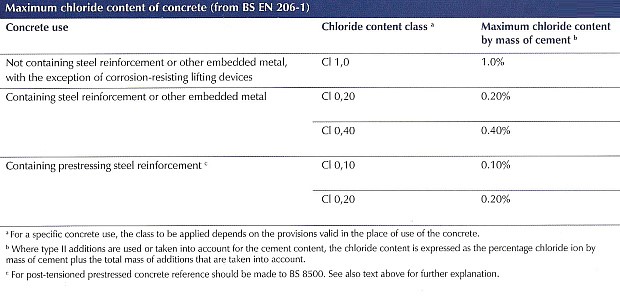Chlorides may be present in concrete from other constituent materials, eg. cement and admixtures, the contribution from aggregates should therefore be kept in perspective.
The issues relevant to chloride content are:
Protection of reinforcement
The use of marine aggregates has not been a significant cause of reinforcement corrosion. Field evidence shows that, provided that the chloride levels in the hardened concrete do not exceed the limits specified in BS8500, and that the normal criteria for concrete quality and depth of cover are applied, there is no significant additional risk from the use of marine dredged aggregate in concrete.
Guidance given in European and British standards for chloride ion content can be summarised as follows-
BS EN 12620
Requires the producer (supplier) to declare the water soluble chloride ion content. (A value of 0.01% may be used if the chloride ion content in the combined aggregate is known to be 0.01% or lower).
BS EN 206 -1
Defines the chloride class depending on type of reinforcing to be used. The class specifies the maximum chloride content on concrete by mass of cement from the total contribution of all the constituents
The actual limits are shown in the table below-

BS 8500 -1
Gives UK guidance on the appropriate chloride class that should be specified. Concrete that has to be prestressed (and concrete containing reinforcement or other embedded metal that is to be heat cured) should be specified as chloride class CL0,01.
However in post tensioned prestressed concrete and unbonded concrete, BS 8500 advises that the chloride class is dependent upon the type of structure, construction method and exposure. For example, for internal post-tensioned office construction, a chloride class of Cl 0,40 is appropriate.
Alkali Silica reaction
Since marine aggregates are petrologicaly similar to adjacent land based deposits they are no more or less susceptible to ASR. There is however a contribution to available alkali from the chloride content. Whilst this contribution is relatively small, it is required to be taken into account by the concrete producer when conforming to the guidelines and specifications relating to minimising the risk of alkali silica reaction. The marine aggregate provider is able to provide chloride ion content certification. Further guidance can be found in BRE Digest 330 (Alkali-silica reaction in concrete).
Control of Chloride during processing
It is not unusual for processing plants to have electronic monitoring equipment installed to assist in the monitoring and management of the chloride content in the wash water during aggregate processing. Testing of the final product forms part of all marine aggregate producers factory control procedures as required by BS EN 12620.
All marine aggregate producers are required to provide chloride ion content certification in compliance with BS EN 12620 and PD 6682-1.

